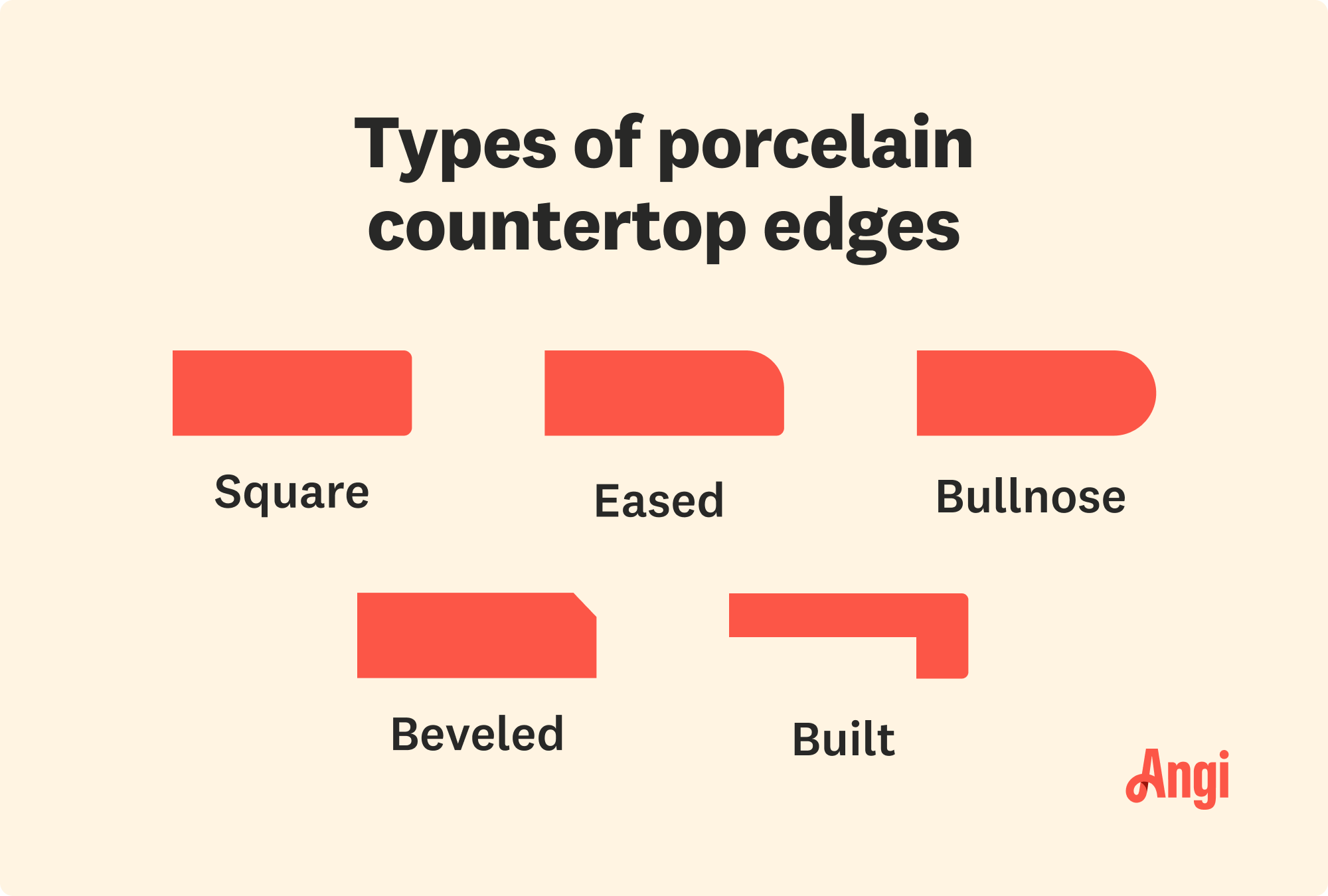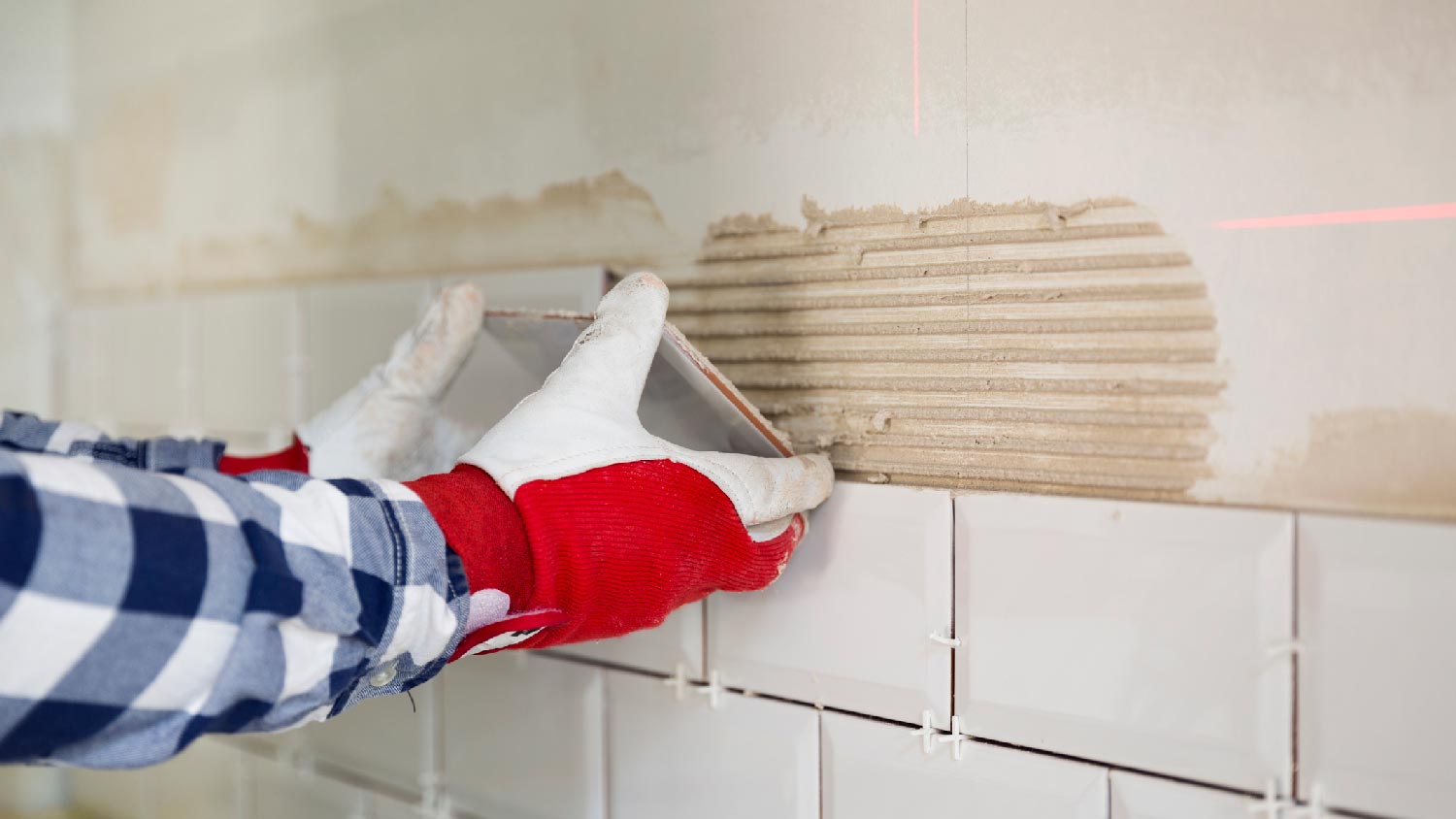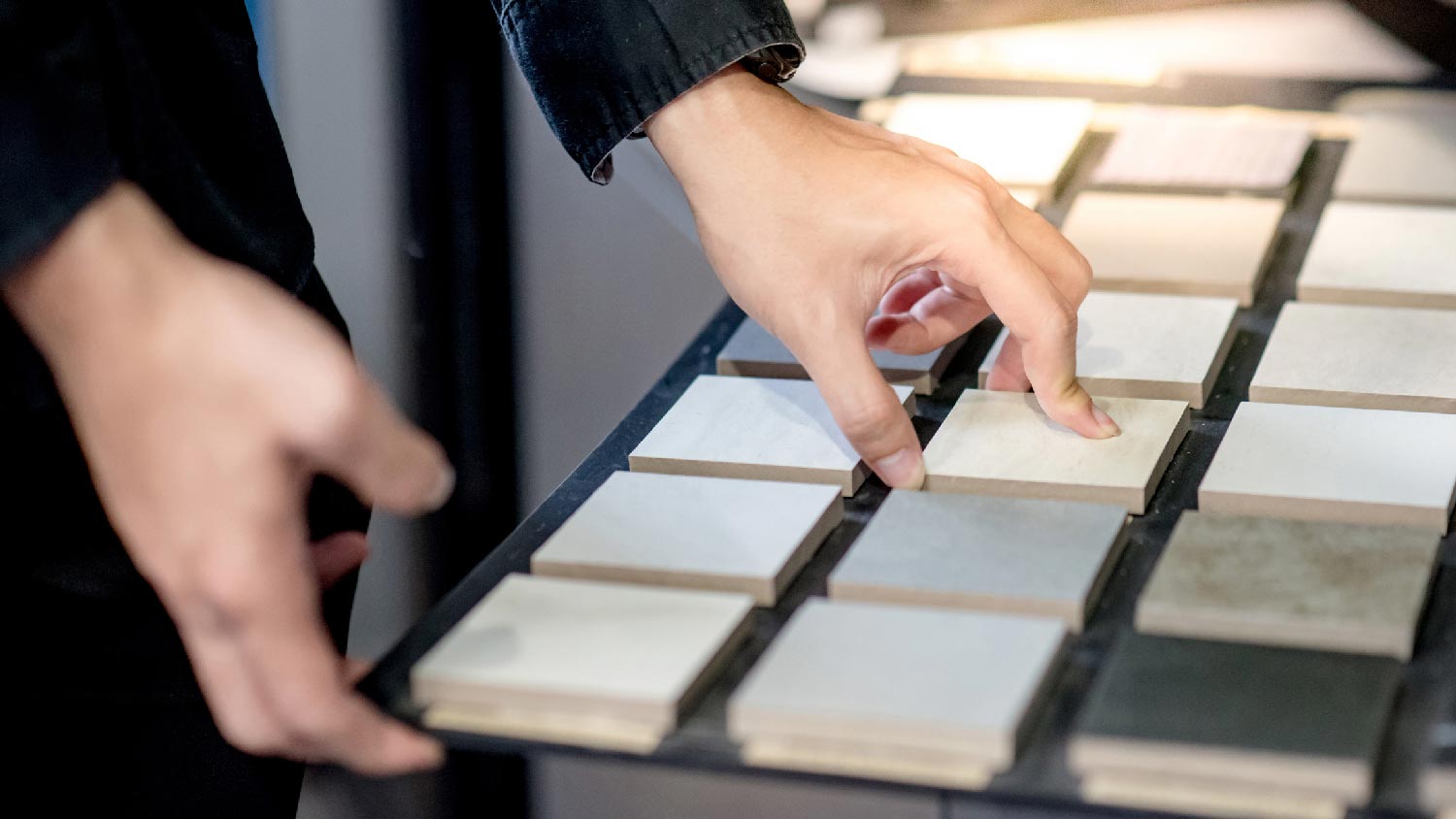How Much Do Porcelain Countertops Cost? [2025 Data]
Most homeowners spend between $1,500 and $3,800—or an average of $2,900—on porcelain countertop installation.


The size and complexity of your countertop design are the most important cost factors to consider. Most pros charge by the square foot.
Porcelain slab countertops cost twice as much as porcelain tile countertops, but they require less maintenance and are easier to clean.
Most professionals include the cost of removing your old countertop in their estimate, but double-check with yours before hiring.
Be sure to budget for permits if you’re rearranging your countertop layout and making changes to the plumbing or electrical systems.
Porcelain countertops cost $50 to $70 per square foot, on average. Though prices can rise for larger projects, most homeowners spend between $1,500 and $3,800—or an average of $2,900—on their installation. This price includes materials and professional labor.
If you’re looking to install kitchen or bathroom countertops, porcelain is one of the most popular choices for a reason. This material has a high heat resistance (don’t fret about hot pots and pans) and is relatively easy to clean and maintain. This guide will help you set your budget.
Porcelain Countertop Cost by Square Foot
One of the largest cost factors is the size of your porcelain countertop. You’ll usually find prices ranging from $10 to $120 per square foot, though the average cost is $50 to $70 per square foot. Most projects, like your standard kitchen or bathroom countertops, are 30 to 40 square feet in total, though larger homes may have larger countertops.
| Room | Countertop Size (Sq. Ft.) | Average Cost of Porcelain Countertops |
|---|---|---|
| Small Kitchen | 20 – 30 | $1,000 – $2,100 |
| Average Kitchen | 30 – 40 | $1,500 – $2,800 |
| Large Kitchen | 40 – 60 | $2,000 – $4,200 |
| Average Bathroom | 30 – 40 | $1,500 – $2,800 |
| Single Bathroom Vanity | 5 – 10 | $250 – $700 |
Porcelain Countertop Cost Factors
Compared to other countertop materials, porcelain is relatively affordable. For reference, Corian countertops cost about the same, but high-end granite or marble can cost considerably more. Despite the modest price tag, certain factors will impact the cost of your porcelain countertop installation. Expect the little details to play a big role.
Countertop Type
| Type of Porcelain Countertop | Average Cost (Materials Only) |
|---|---|
| Slab | $50 – $120 |
| Tile | $10 – $50 |
There are two types of porcelain countertops: porcelain tile and porcelain slabs. Porcelain tiles cost about $2 to $30 per square foot, while porcelain slabs cost $20 to $65 per square foot. The material costs aren’t dramatically different when you factor in grout and adhesive—especially if you seal your grout, which helps prevent staining.
Even if material costs are similar, the installation makes porcelain slabs the pricier option. Slabs are thin and fragile, so your contractor will need to take extra care to avoid cracking your countertop.
Type of Edge

You may find that porcelain has limited edge options compared to other materials. This is because the pattern and glossy glaze are only surface-deep, and the edges must be created during fabrication. Square and eased edges don’t cost extra, but beveled and bullnose edges may cost an additional $10 to $12 per square foot. More complex built edges may cost $15 to $25 per square foot.
Type of Finish

Porcelain comes in fewer finishes than other countertops. You can choose from polished or unpolished. An unpolished finish will add about $1 per square foot to your total costs. Not every porcelain pattern will be available in both finishes, but you can usually get the most popular looks (which mimic natural stone) in either.
Cutouts
If you choose a porcelain slab, your contractor may need to cut the countertop to make room for accessories like a sink, cooktop, or outlet. Expect to spend around $100 to $200 per cutout. Since this type of countertop is so fragile, it’s important that you hire an experienced contractor who understands how to cut porcelain.
Removal
If you’re replacing countertops, you’ll need to remove your old countertop first. Some contractors charge around $50 to $300 for the removal and disposal of the old materials because it’s extra labor.
Labor
In general, expect to spend an average of $10 to $20 per square foot on professional labor for your installation. Costs vary depending on the location. If you live in an area with a higher cost of living, you can expect to pay higher prices for labor.
Permits
In general, permits cost about $50 to $500, depending on what’s required by your local municipality. You may not need a permit if you’re replacing your existing countertop with a countertop of the same size. You will need a permit if your project involves plumbing or electrical work.
Ongoing Porcelain Countertop Costs
Porcelain countertops are durable, especially regarding heat resistance, which is ideal for a kitchen. You’ll still need to maintain them properly. The good news is that maintenance is generally wallet-friendly. You may need to make some repairs along the way, but it shouldn’t happen often.
Repairs
Porcelain countertops are somewhat vulnerable to chips and cracks, even if they withstand stains and scratches. With an epoxy fissure repair kit, you can fix small cracks (or at least stop them from worsening). Depending on the damage, a professional typically charges $150 to $800 per repair.
Tile Replacement
If you opt for porcelain tiles, you may need to replace a chipped or cracked tile eventually. This can happen if you drop a heavy object on your countertop. Expect to spend about $120 to $500 on tile replacement.
Grout Cleaning and Repair
If you have tile, you may need to clean or repair your grout occasionally. Grout, in particular, is prone to staining (unless it’s sealed) and crumbling. Expect to spend around $100 to $700 on grout repairs, with the average cleaning ranging from $100 to $475.
DIY Porcelain Countertops vs. Hiring a Pro
DIY porcelain countertops cost anywhere from $750 to $3,500—about two to three times less than a professional installation. Tile is more suitable for a DIY than slab since slabs are very thin and prone to cracking before installation. Alternatively, you can choose smaller slabs that function like a larger tile but have limited seams. Plus, cleaning up after a meal is easier with fewer grout lines.
The best way to make sure you don’t damage your countertop during installation (and have to spend on a replacement) is to hire a countertop contractor near you to take on the project. Beyond that, don't attempt a DIY if your installation requires any electrical or plumbing work. You’ll likely need a licensed pro to get a permit.
Cost of Common Porcelain Counter Add-Ons

There are a few different jobs homeowners commonly add to their countertop installation. If you’re planning a bathroom or kitchen renovation, you can usually save money by grouping related jobs. For example, if you’re upgrading your countertops, you might also want to upgrade your sink or cooktop. Here are some extra expenses to consider.
| Add-On Project | Average Cost |
|---|---|
| Backsplash Installation | $600 – $1,300 |
| Sink Replacement | $250 – $1,600 |
| Appliance Installation (Labor Only) | $70 – $225 |
| Cabinet Refacing | $5,000 – $10,600 |
| Cabinet Refinishing | $700 – $6,000 |
| Kitchen Island Installation | $2,500 – $10,000 |
Backsplash Installation
You may want to install a new backsplash to match your new countertop. A kitchen backsplash generally costs $15 to $40 per square foot for installation, depending on the material. If you use porcelain tile, your backsplash installation will have a similar cost to your countertop installation. Most homeowners spend $600 to $1,300 on a backsplash.
Sink Replacement
A sink replacement costs $250 to $650 on average, though it can cost more than $1,600 depending on the model. Copper sinks cost the most, but a simple drop-in or undermount sink can run you as little as $250.
Appliance Installation
If you’re upgrading your kitchen countertops, you may want to upgrade your appliances. Homeowners often install a new cooktop, stove, refrigerator, or microwave. Expect to spend about $125 to $300 on appliance installation costs—plus the cost of the appliance itself.
Cabinet Refacing or Refinishing
Some homeowners choose to reface or refinish their cabinets when installing new countertops. This can give your cabinets a fresh new look without the cost of a full replacement. On average, cabinet refacing costs around $7,250, and refinishing costs $3,000. Painting and staining alone costs $4 to $10 per square foot.
Adding a Kitchen Island
If you’re installing new countertops and always dreamed of having a kitchen island, now is your chance. On average, homeowners spend about $4,000 installing a new kitchen island, depending on the size. Permanent prefab islands typically cost $2,500 to $3,500.
How to Save on Porcelain Countertop Costs

Porcelain is a great option for homeowners with a mid-range budget. It’s not the most expensive but isn’t considered low end. If you’re looking to install kitchen countertops on a budget, there are some ways you can lower the cost of porcelain. You just have to get creative.
Choose tiles over slabs
Go with larger tiles
Opt for standard edges and finish
Do the demolition yourself
Bundle similar projects for a reduced rate
Get multiple quotes
Pros and Cons of Porcelain Countertops
Porcelain countertops are quickly gaining popularity because they’re attractive and long-lasting. But that doesn’t mean they’re the right option for every homeowner. Here are some benefits and drawbacks of porcelain countertops in your home.
| Pros | Cons |
|---|---|
| Sturdy | Surface-only design |
| Versatile | Costly |
| Easy to clean | Less available |
| Sustainable | Design choices can reduce functionality |
| Easy to install |
Frequently Asked Questions
Porcelain and granite countertops can be similar in price, but it depends on the quality of the granite. Granite slab installation generally costs $50 to $200 per square foot, while the average porcelain countertops cost $50 to $70 per square foot. High-end granites, like Blue Louise and Costa Esmeralda, cost significantly more than porcelain—especially if you choose a high-end finish—but you can choose a lower-quality stone for a similar price.
Porcelain countertops are slightly more affordable than quartz. Most quartz countertops cost $50 to $200 per square foot, whereas porcelain typically costs $50 to $70 per square foot. However, lower quality builder’s grade quartz is similar in price to porcelain. This type of quartz contains more resin and fillers, making it less vibrant.
Porcelain is a relatively affordable, mid-range countertop. It’s less expensive than other popular materials, including quartz, slate, concrete, and marble. It’s similar in price to the average, low-end or mid-range granite or quartzite countertop (high-end options cost more). It’s more expensive than laminate, acrylic, and ceramic.
However, note that porcelain doesn’t come with very many long-term maintenance costs. If it breaks, you’ll still need to make repairs, but it won’t need regular sealing like concrete and natural stone.















